6 Mapping Motifs and Techniques: Tracing the Development and Transmission of Cupisnique-style Engraved Head Images
Yumi Park Huntington
https://doi.org/10.52713/ARAM8873
“Social and environmental changes and external contacts, for example,
are evident in the archaeological records of ancient societies,
especially in the form of changes in pottery, which immediately
reflects changes that affect the members of a society.”
– Terence Grieder, “The Interpretation of Ancient Symbols”, 1975
Cupisnique Ceramics
Ancient societies along the West Coast of South America produced some of the earliest and most sophisticated pottery styles of all Pre-Columbian civilizations. The Cupisnique (koo-pis-NEE-kay) style is named for the quebrada located between the Jequetepeque and Chicama rivers on the northern coast of Peru; the term is more generally used to refer to archaeological objects found in this and nearby regions (Map 6.1). Thousands of Cupisnique-style ceramic objects have been assembled in both public and private collections worldwide, including approximately 180 dark-colored, stirrup-spouted, Cupisnique-style ceramic vessels filling the cabinets in the public storage rooms of the Museo Arqueológico Rafael Larco Herrera (hereafter Museo Larco) in Pueblo Libre, Peru, a suburb of Lima. On my first visit to the museum in 2008, these objects captured my eyes, not because of their shiny surfaces or their unusual stirrup spouts, but because of the subtle linear motifs engraved on their surfaces. The Museo Larco digital database makes photographs of these objects available online,1 and many are illustrated in ancient South American publications, but the small details of these engraved motifs are really only clearly visible with close, in-person inspection. I was already familiar with such motifs from two Cupisnique style ceramic vessels in the Ancient American collection of the Virginia Museum of Fine Arts (hereafter VMFA) in Richmond, Virginia (Figures 6.1 and 6.2), but it was not until I encountered the abundance of such motifs in the collection of the Museo Larco that I gave them proper attention and realized their importance as indicators of broader cultural patterns.

Drawing by Eric Huntington.
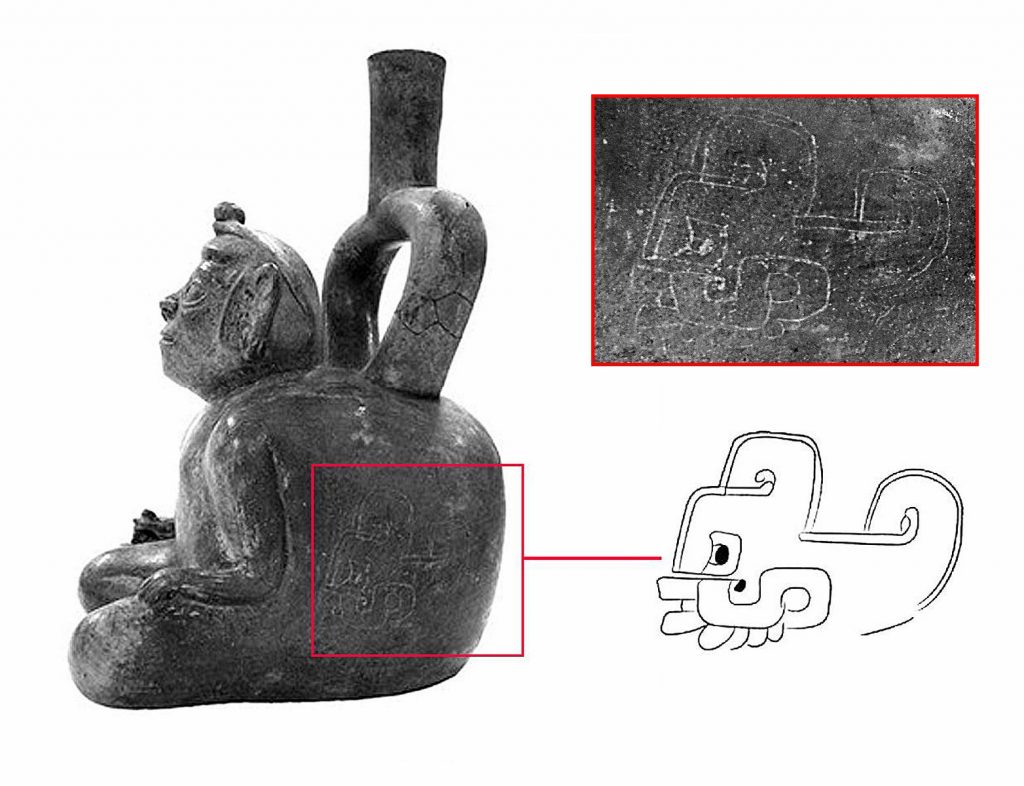
Photo and drawing by Yumi Park Huntington.
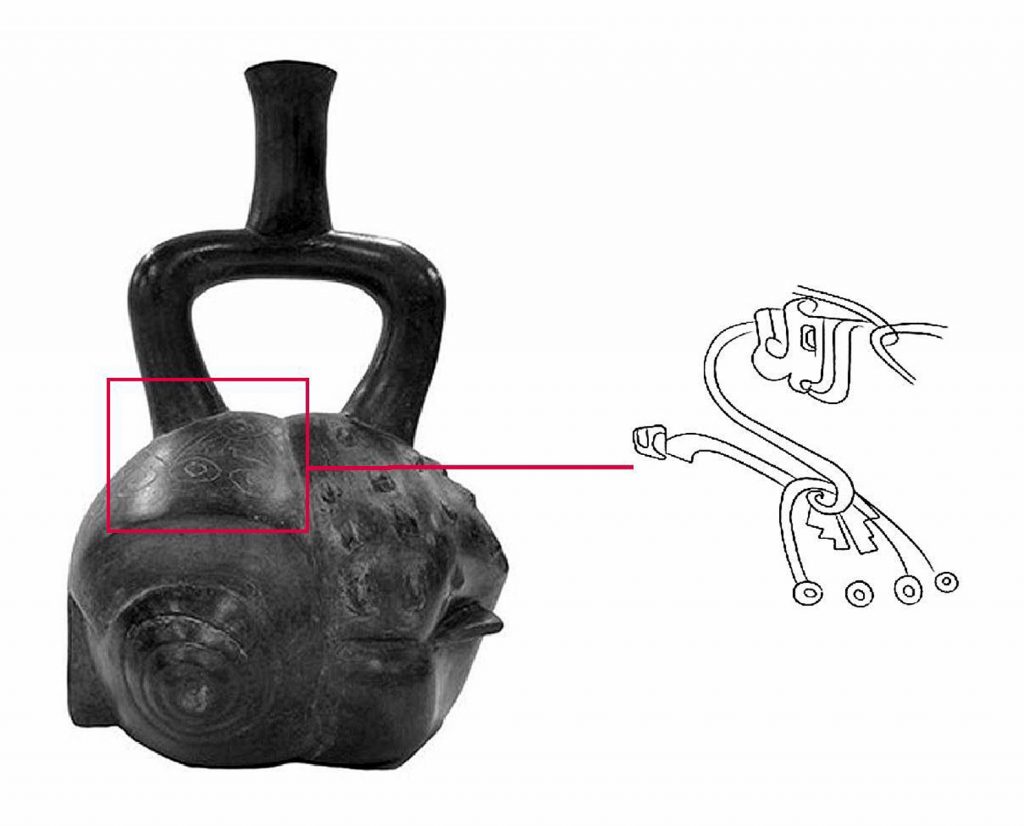
Photo and drawing by Yumi Park Huntington.
The motifs, which generally focus on imagery of human heads with animal features, range from little more than a few ragged scratches to large and intricate designs. Many of these motifs are engraved after the final firing completely hardens the smooth clay surface, so the qualities of their lines differ dramatically from motifs that are drawn before firing. The roughness and thinness of the lines seems to have been intentional, as it would have been easy to create a different line quality using another technique. A line created before firing, for example, could be smooth and precise. Despite such obvious distinctions, however, it can be difficult to determine the precise characteristics and techniques used to create some of these motifs, as the engravings may be filled with dirt even after excavation or have been eroded or damaged in other ways, making them difficult to discern. Even so, the apparently unique combination of head motifs and post-firing engraving in Cupisnique ceramics became a focal point in my interpretation of the symbolism of the designs and their cultural value (Park 2010, Park Huntington 2018).
In order to better understand their cultural context, it is typically crucial to know the precise geographic sites where these objects were made, used, buried, and subsequently unearthed. Because many of these vessels were unearthed without the precision of modern archaeology, however, detailed records of their excavation were not kept. The central contribution of this paper is thus to attempt a reconstructive mapping of the general origins of these vessels and thereby more precisely analyze geographic and cultural differences among them. While they all may be said to be in the Cupisnique style, in fact there appear to be regional differences within this style that may reveal local cultural differences and be productive for further analyses.
The term “Cupisnique” was first applied to ceramic vessels by Rafael Larco Hoyle in the early 1930s, based on his many excavation projects throughout the region of these two valleys and centered on the Cupisnique quebrada (Larco Hoyle 1941, 1945). Based on the collection of other vessels with similar characteristics from surrounding regions, the Cupisnique stylistic region was expanded to include the Chancay and Zaña valleys in addition to the Jequetepeque and Chicama.2 The recognition of this style and the coinage of the term “Cupisnique” to refer to a distinctive local culture were extremely important, as they enabled scholars to contemplate the possibility of local developments in ceramics outside Tello’s dominant theory of Chavín-centered societies.3 During the Middle, Late, and Final Formative periods (c.1200–200 BCE), many different societies developed and flourished in the coastal and highland regions. Although these societies were previously collectively identified as Chavínoid, based on the fang motifs on their objects, current Andean scholarship now recognizes the greater diversity of cultures that occurred in these regions, and focuses on individual styles and specific cultural developments. The shared styles and forms of objects that prompted previous identifications as Chavínoid are not likely to be the result of a one-way influence from Chavín society to all others. Rather, the styles of these objects probably emerged from a variety of reciprocal interactions (Lumbreras 2013: 186). Even the Cupisnique style itself is almost certainly the result of various interactions among local communities.
Many Cupisnique-style ceramics excavated in the four valleys that define the region share characteristics of black or brown color, stirrup-spouted shape, and thinly engraved head motifs that relate to the imagery of other neighboring cultures (Park Huntington 2018). Unfortunately, the development of the technique of post-fire engraving has not been mapped either historically or geographically based on the archaeological record. While it is widely recognized that this technique first appeared in the late Formative period (c.1200–200 BCE), much more remains to be known about how post-fire decorative techniques spread through the region over time, for example also appearing in Paracas objects, and when and where the specific motifs of Cupisnique imagery appeared. Mapping the excavation locations of individual objects allows progress beyond the identification of a general Cupisnique style to trace local developments and transmissions even within this region previously defined only by a single name. Furthermore, analysis of technique and imagery also provides insights into the cultural values and social structures of the larger region. Since the combination of post-firing engraving and head motifs in Cupisnique vessels can be understood as an emblem of Cupisnique cultural identity within the broader Andean political environment (Park Huntington 2018), further analysis within the Cupisnique region is likely to reveal more finely-detailed cultural relationships.
Theoretical Approach and Methodology
How can motifs, designs, and images be used to understand ideas, symbolism, and social structures from an ancient culture without written records? The engraved motifs on the 62 Cupisnique vessels examined in this essay show that even subtle differences in material objects can be correlated to real historical and social circumstances. Indeed, scholars like Paul Wason have argued that social structures and interactions affect, and are therefore recorded in, material objects and artistic expressions (Wason, 1994).
In the discipline of art history, two fundamental modes of interpretation described by Erwin Panofsky are traditionally applied: iconography and iconology (Panofsky 1970). Iconography, from the Greek eikōn (image) and –graphia (writing/drawing), is the interpretation of the subjects of images as distinct from their formal characteristics, while iconology, from –logia (discourse),4 is the explanation of artistic works in terms of cultural, social, and historical contexts. As Terence Grieder argued, however, even iconographic analysis requires addressing both formal and ethnographic elements (Grieder 1975). Indeed, cultural traditions are crucial to contextualizing even artifacts that were created for utilitarian purposes (Margolis and Laurence, 2007). While ceramic plates are generally used simply to hold food, plates from Pier 1 Imports and Wedgwood clearly hold different social values in a capitalist society. Beyond just discussing the aesthetics of artifacts, art historians have several approaches to address meaning and cultural context, even for objects that were created for limited purposes and with little concern for beauty.
This article adopts Grieder’s approach of combining formal, pictorial, symbolic, and cultural analyses to interpret the Cupisnique-style head-motifs from the four different valleys in the relevant period, c. 1200–200 BCE. The main limitation in applying Grieder’s methods here is the complete lack of ethnographic context for the Cupisnique culture(s), due to the absence of written documents in the Andean region before the Spanish arrival and the middle of the 16th century. Later documents by Pedro de Cieza de Leon, Bernabé Cobo, Titu Cusi Yupanqui, and Felipe Guamán Poma de Ayala documented mainly the Inka culture from a contemporary colonial perspective, centuries after the Spanish conquest. These documents thus prove difficult to use even to understand the Inka, let alone cultures that flourished long before the Inka and in other geographic regions. The Cupisnique was a relatively small culture localized to the northern coast of Peru, and, although it influenced later Moche and Chimu cultures, such later written records are only distantly relevant. Therefore, this paper seeks to find cultural information that may substitute for ethnography in the visual and technical details of the material objects. Based on analysis of both the motifs on the vessels and the techniques used to engrave them, it is possible to understand specific cultural information about this region and the people who made these ceramics.
The following analysis proceeds in three parts. First, the motifs on the ceramics are typologized and mapped to the regions of their excavation, as far as is possible with available data. This allows a division of different types of Cupisnique-style motifs by sub-region and suggests a diversity of local traditions within the larger Cupisnique category. While more research remains to be done about how these regional differences relate to local cultural differences, such mapping is an important first step. It also may allow the more accurate attribution of newly-found Cupisnique-style objects without provenance, when they appear in collections around the world.
For this essay, a total of 62 vessels in the Cupisnique style were analyzed, the complete number for which either a regional or more specific geographic point of origin could be assigned.5 At least 173 vessels in the Cupisnique style possess engraved head motifs, so this sample represents slightly more than one-third of known, related objects. Unfortunately, find-site data for the other 111 vessels is simply not documented. Of the 62 analyzed, 30 are housed in the Museo Larco collection, and all of these come from the Chicama region. Because of the more detailed records of the Museo Larco, it was also possible to link each of these objects with specific cities or localities within the Chicama Valley region, allowing for even more fine-grained analysis.6 The other 32 vessels are housed in private collections and listed with geographic attribution by Alva (1986).7 For the most part, these objects are associated only with valley regions and not specific sites. Still, although the sample is not comprehensive and the find-site data is not always specific, it is possible to make some significant conclusions about the differing geographic distribution of specific motifs and motif configurations in the Cupisnique style.8
In the second section of analysis, the techniques used to make the Cupisnique-style objects are described and shown to be not just stylistic concerns but matters of deeper cultural context. Even in the absence of ethnographic data, it is possible to correlate cultural concerns with the analysis of artworks, especially the value of specific techniques for particular ritual functions or expressions of cultural identity. Building on the theoretical foundations described above, this section incorporates further technical analyses by other scholars to show the specific factors at play in the Cupisnique period.
Having established the local geographic distribution of objects within the Cupisnique region and their value within those societies in the first two sections, the third section examines several Cupisnique-style objects that were excavated outside the Cupisnique region to further explore the style’s broader significance and value among other various cultures across the Andes. Given the more nuanced view of local variation in the Cupisnique style provided in the first sections, it is possible to suggest more precise relationships between distant regions and particular locations within the Cupisnique cultural sphere.
Quantifying Cupisnique Head Motifs
Cupisnique motifs may be typologized by breaking them down into parts, essentially identifying the specific characteristics that come together to form a complete image. Since all known head motifs include a certain set of requisite features (such as eyes, nose, and mouth), these may be understood to form a basic head pattern to which other, optional characteristics (such as fangs or feathers) may be added (Figure 6.3). The basic head pattern, even when it appears as a complete motif without other characteristics, is not necessarily historically prior or symbolically more central, but since its features seem always to be found together, it may be treated as an essential unit. The optional characteristics may then be identified separately, with each part assigned a single letter to simplify description of different configurations:
- A – basic head
- B – distinct fangs
- C – rows of teeth
- D – connective band
- E – elongated body
- F – feathers
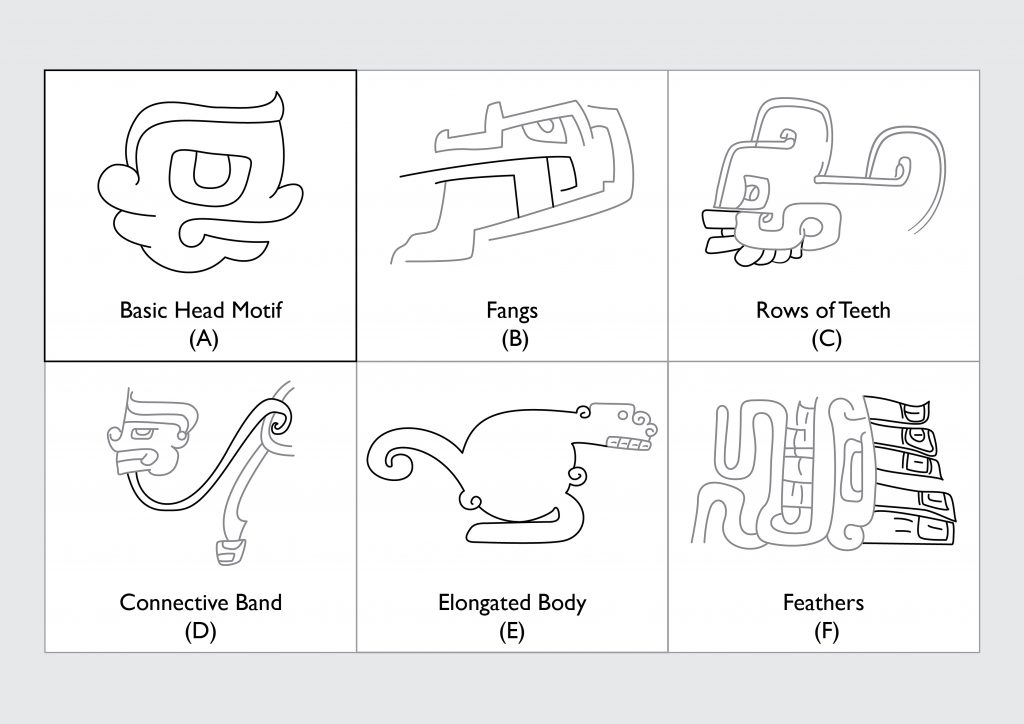
Drawing by Eric Huntington, from Park Huntington 2018.
Thus, an image of the basic head in isolation can be abbreviated as A, while an image of a head with fangs and a connective band can be abbreviated as ABD.9 A complete list and description of the configurations that have been identified can be found in Table 6.1. The 62 head motifs analyzed for this paper were each given a descriptive code and mapped to the specific region where they were unearthed (Tables 6.2-6.7). Based on available data, the locations cannot be linked to specific archaeological sites but only to the names of nearby valleys or, in some cases, cities. All of the vessels were from the region of the Chancay, Zaña, Jequetepeque, and Chicama Valleys on the northern coast of Peru, and the vast majority were from Jequetepeque or Chicama. The following charts indicate the quantity, location, motif, and motif types from each region. All of the examples are from private collections, except for the objects from Chicama, which are held in the Museo Larco.
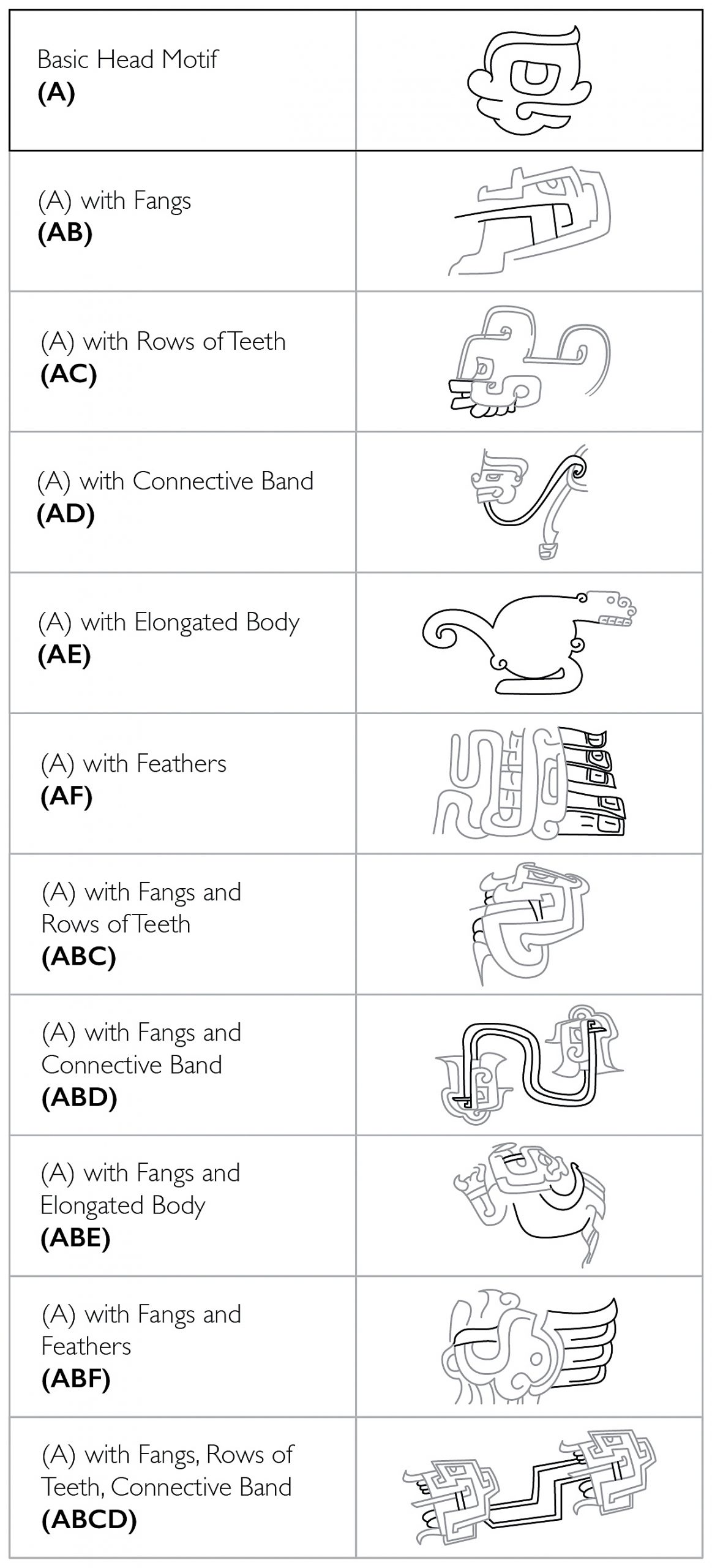
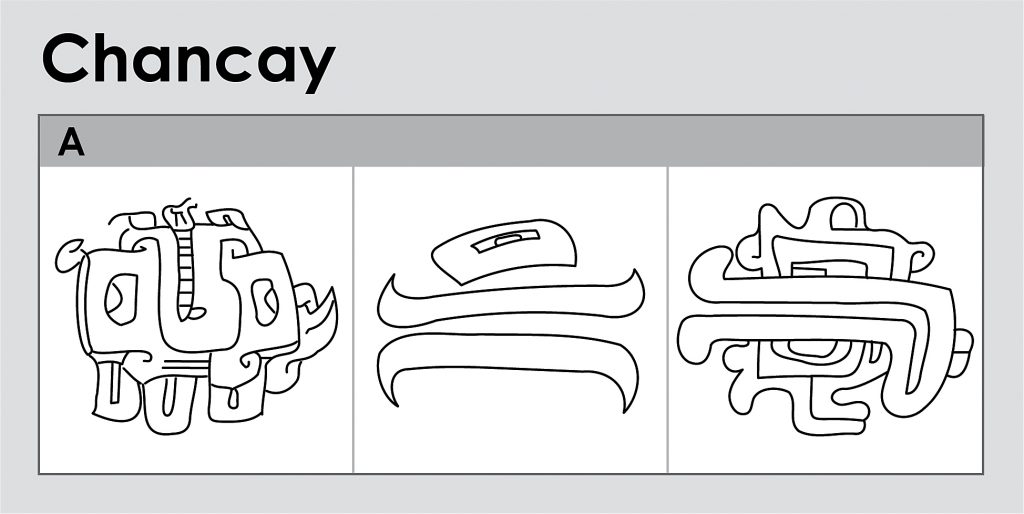
Adapted from Alva 1986, drawing by Eric Huntington.
Only three vessels were identifiable from the Chancay Valley, and all of these exhibited the basic head configuration (A) without other characteristics .
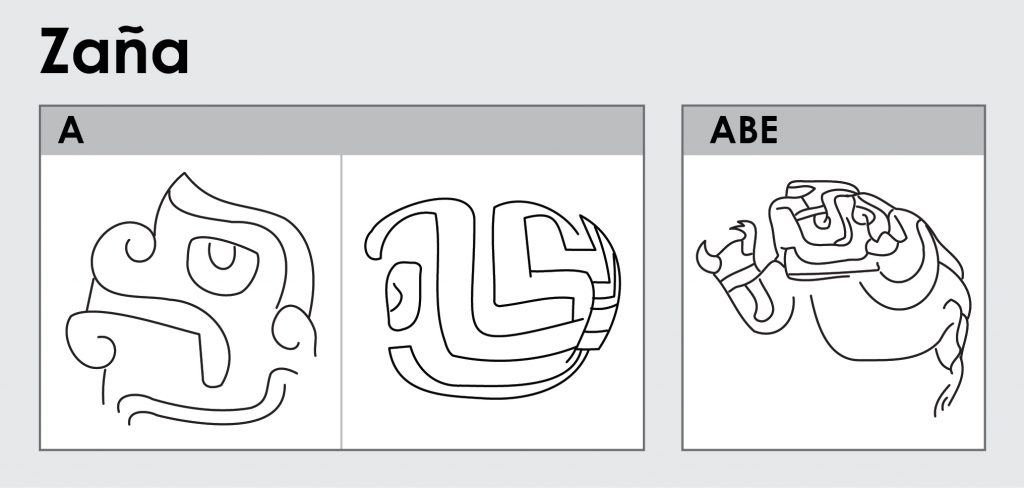
Adapted from Alva 1986, drawing by Eric Huntington.
Only three vessels were identifiable from the Zaña river valley. Of these, two exhibited the basic head (A) in isolation, and one showed the head with fangs and elongated body (ABE).

The examples labeled Limoncarro and Quindén are from specific sites by those names. The precise geographic origins of the other examples are unknown.
Adapted from Alva 1986, drawing by Eric Huntington.
The Jequetepeque examples were far more varied, possibly because of the significantly larger sample size of 24 vessels identifiable from this region. All characteristics except elongated body (E) could be found among these examples.
- All included the basic head (A)
- 5 included fangs (B)
- 6 included rows of teeth (C)
- 2 included connective bands (D)
- 1 included feathers (F)
A total of seven different configurations were in evidence:
- 14 examples of A
- 1 example of AB
- 3 examples of AC
- 1 example of AD
- 1 example of AF
- 3 examples of ABC
- 1 example of ABD
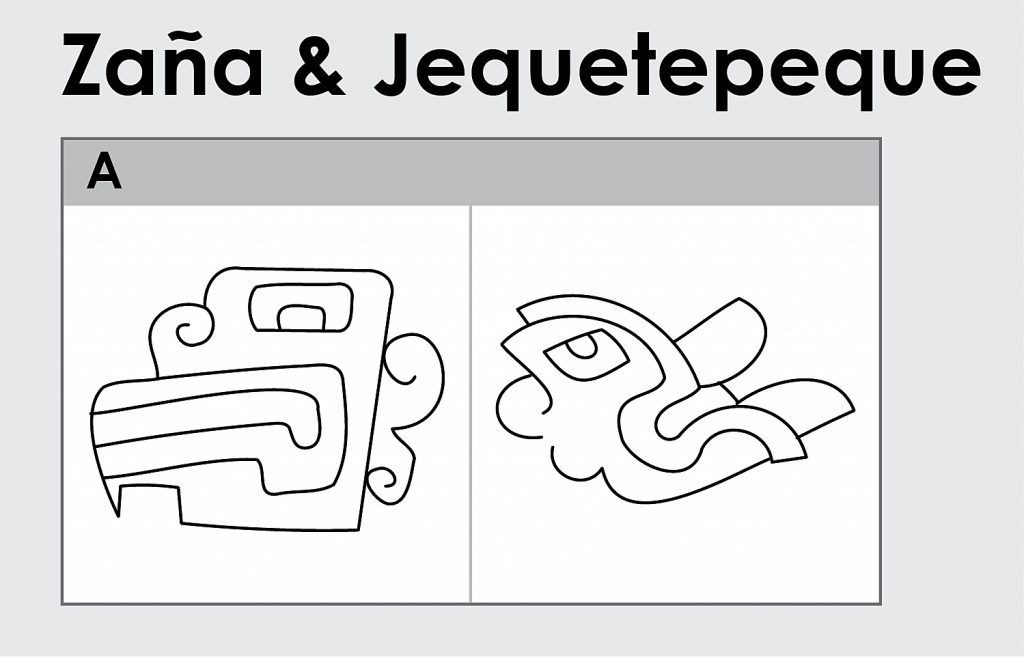
Adapted from Alva 1986, drawing by Eric Huntington.
Although the Zaña and Jequetepeque Valleys are separate, Alva (1986) did not always make a distinction in his attributions. Because no further information is available, I have retained his interpretation of these as a combined category. Fortunately, only two Cupisnique-style vessels with engraved head motifs were attributed to the Zaña & Jequetepeque region, and both of these exhibited the basic head in isolation (A).

Adapted from Alva 1986, drawing by Eric Huntington.
As with Jequetepeque, a significantly larger and more varied sample (30 vessels) was identifiable from the Chicama region. All known features (A, B, C, D, E, F) were found among these samples.
- All included the basic head (A)
- 23 included fang motifs (B)
- 12 included rows of teeth (C)
- 9 included connective bands (D)
- 1 included elongated body (E)
- 4 included feathers (F)
A total of 10 different configurations were in evidence:
- 2 examples of A
- 5 examples of AB
- 1 example of AC
- 1 example of AD
- 1 example of AE
- 2 examples of AF
- 8 examples of ABC
- 5 examples of ABD
- 2 examples of ABF
- 3 examples of ABCD
Sites Within the Chicama Valley (further breakdown of the same vessels in Table 6.6):
The Chicama Valley is the only region for which Larco Hoyle (1941) recorded where the vessels were unearthed in terms of the locations of modern cities, in this case, Barbacoa, Roma, Casa Grande, Santa Ana, and Sausal. As such, a more detailed analysis is possible in this region.
Barbacoa (8 vessels): The eight vessels from Barbacoa exhibited all features except for elongated body (E).
- All included the basic head (A)
- 6 included fangs (B)
- 3 included rows of teeth (C)
- 2 included connective bands (D)
- 2 included feathers (F)
The eight vessels from Barbacoa occurred in six (6) different configurations:
- 2 examples of AB
- 1 example of AD
- 1 example of AF
- 2 examples of ABC
- 1 example of ABF
- 1 example of ABCD
Roma (1 vessel): The one vessel from Roma occurred in AB configuration.
Casa Grande (4 vessels): The four vessels from Casa Grande exhibited all features except for feathers (F).
- All included the basic head (A)
- 2 included fangs (B)
- 1 included rows of teeth (C)
- 2 included connective bands (D)
- 1 included elongated body (E)
Each of the four vessels from Casa Grande had a different configuration: A, AE, ABD, ABCD.
Santa Ana (7 vessels): The seven vessels from Santa Ana exhibited all features except for elongated body (E).
- All included the basic head (A)
- 4 included fangs (B)
- 3 included rows of teeth (C)
- 1 included connective bands (D)
- 1 included feathers (F)
The seven vessels from Santa Ana exhibit six (6) different configurations of motifs: A, AB, AC, AF, ABC (in 2 vessels), ABD.
Sausal (10 vessels): The ten vessels from Sausal exhibited all features except for elongated body (E):
- All included the basic head (A)
- All included fangs (B)
- 5 included rows of teeth (C)
- 4 included connective bands (D)
- 1 included feathers (F)
The ten vessels from Sausal occurred in five (5) different configurations:
- 1 example of AB
- 4 examples of ABC
- 3 examples of ABD
- 1 example of ABF
- 1 example of ABCD
The cities of Casa Grande, Santa Ana, and Roma lie towards the lower end of the Chicama Valley (toward the coast), while Sausal and Barbacoa are closer to the middle of the valley (somewhat inland). It may be notable that only Casa Grande, towards the lower end of the valley, has an example of the elongated body (E), and that these vessels also lacked any feathers (F) that could be found at most of the other sites in the region.
Overall Patterns
Given this sample of 62 head-motif vessels with various combinations of features and locations of origin, some general analyses are possible. Using these overall characteristics of the entire sample set as a baseline, one can also compare subset samples from different regions to see how they match or differ from the overall distribution and from each other.
Considering the complete set of 62 vessels as a whole, the basic head (A) is a part of all (100%) of the designs. 29 vessels (47%) included fangs (B), 18 vessels (29%) included rows of teeth (C), 11 vessels (18%) included connective bands (D), 2 vessels (3%) included elongated body (E), and 5 vessels (8%) included feathers (F).
Out of all numerically possible configurations of these individual characteristics, only 11 combinations actually appear on the vessels surveyed in this study (Table 6.1). The frequencies of these configurations are listed below (percentages do not total one hundred due to rounding):
- A = 23 (37%)
- AB = 6 (10%)
- A = 4 (6%)
- AD = 2 (3%)
- AE = 1 (2%)
- AF = 3 (5%)
- ABC = 11 (18%)
- ABD = 6 (10%)
- ABE = 1 (2%)
- ABF = 2 (3%)
- ABCD = 3 (5%)
The basic head in isolation (A = 23) is by far the most common configuration, followed by various configurations of the head with fangs, including with teeth (ABC = 11), with fangs alone (AB = 6), and with fangs and connective bands (ABD = 6). A much smaller number of vessels omitted fangs (B) but had other features such as teeth (AC = 4), connective bands (AD = 2), elongated body (AE = 1), or feathers (AF = 3).
Some characteristics were never found together. Neither rows of teeth (C) nor connective bands (D) ever occurred with elongated body (E) or feathers (F). These latter features, elongated body (E) and feathers (F), only occurred either without any other additional features besides the basic head (AE, AF) or in combination with fangs (ABE, ABF). Likewise, elongated body (E) and feathers (F) were never found to combine with each other. ACD was also not found as an independent combination, although A, C, and D may occur together if B is also included (ABCD).
The only extant configuration with more than three characteristics is ABCD (found in three objects from Chicama).
Distribution of Characteristics and Combinations by Region
Based on the mapping of these characteristics and configurations to their apparent excavation regions, it seems that some certain types of imagery can be localized to specific river valleys or regions. The pattern that emerges is one of more complex imagery in the southern regions, as compared to the simpler configurations that dominate further north, as summarized in Figure 6.4 and Table 6.7.
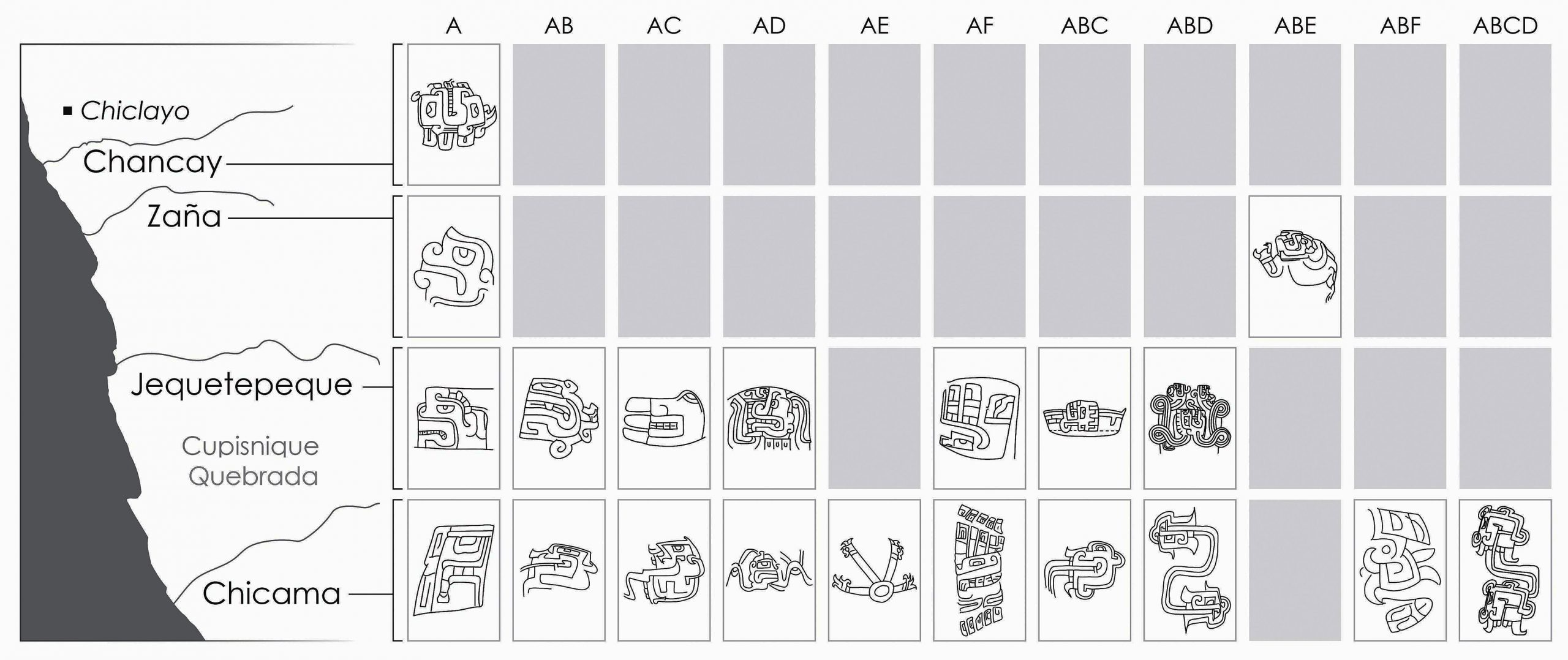
Drawing by Eric Huntington, from Park Huntington 2018.
| CONFIGURATION | REGION | |||
| Chancay | Zaña | Jequetepeque | Chicama | |
| A | 3 | 4 | 14 | 2 |
| AB | 1 | 5 | ||
| AC | 3 | 1 | ||
| AD | 1 | 1 | ||
| AE | 1 | |||
| AF | 1 | 2 | ||
| ABC | 3 | 8 | ||
| ABD | 1 | 5 | ||
| ABE | 1 | |||
| ABF | 2 | |||
| ABCD | 3 | |||
| Table 6.7: Configuration Distribution by Regions |
||||
Fangs (B) appear on at least some objects from every valley except Chancay, the northernmost of the four valleys associated with the Cupisnique style. While the sample size from Chancay is extremely small (only 3 objects), it may be that this characteristic was not as popular in the northern regions. Indeed, this hypothesis is supported by the additional fact that fangs seem fairly rare in the middle-southern Jequetepeque Valley (5 out of 24 samples = 21%) and significantly more common in the southernmost Chicama Valley (23 out of 30 samples = 77%). Furthermore, the frequency of fangs in Chicama is much greater than that of the overall sample (47%). Given this distribution, it may be that fangs, as a characteristic, were more associated with the southern artistic traditions, especially the southernmost.
Likewise, rows of teeth (C), connective bands (D), and feathers (F) only appear on the vessels from the Jequetepeque and Chicama Valleys, both of which are located in the southern half of the Cupisnique stylistic region. Again, while the relatively small sample size from the northern regions may be a factor, it may also be that the more complex imagery with these additional features was more common toward the south. As occurred with the fangs (B), imagery from southernmost Chicama uses these features even more frequently than middle-southern Jequetepeque, supporting an interpretation of greater popularity further south. Rows of teeth (C) occur at a rate of 25% (6 out of 24) in Jequetepeque, compared to 60% (18 out of 30) in Chicama. Connective bands (D) occur at a rate of 8% (2 out of 24) in Jequetepeque, compared to 37% (11 out of 30) in Chicama. Feathers (F) occur at a rate of 4% (1 out of 24) in Jequetepeque, compared to 13% (4 out of 30) in Chicama. Unless more objects with these characteristics from the northern valleys are identified, it seems that they are far more common as one progresses south.
The elongated body (E) is the least common characteristic of all, only being found in two vessels from the Chicama and Zaña Valleys. While Alva previously connected motifs from the Zaña Valley and the Jequetepeque Valley, due to their neighboring physical location, it may be that certain aspects of the Zaña motifs were in fact more closely related to the Chicama Valley traditions, given this unique appearance of the elongated body in both places. Given the distribution of more individual features toward the south, and especially toward Chicama, it also follows that many of the more complex configurations are also more common in the same places.
Even given the relatively small sample size in some of the regions, it seems quite possible to divide the Cupisnique style into several regional sub-styles, based on the known find-sites of available ceramics. While better excavation and provenance information will undoubtedly refine these analyses in the future, several patterns have emerged. In general, it seems that the imagery is more complicated in the southern valleys than in the northern ones. This pattern holds even between the Jequetepeque and Chicama Valleys of the southern region, where the sample size is much more robust.
Such analysis can provide great insights into the cultural contexts and societal relationships between these different regions, although more research remains to be done. It may be that the center of the Cupisnique culture was indeed near the Cupisnique quebrada, or perhaps it was rather closer to the Chicama river valley, with the most complex and varied motifs being developed there. Surrounding regions may have only later adopted the most basic elements of southern Cupisnique design, based on limiting religious, economic, or other cultural factors. Alternatively, the simpler designs might have developed first in the north and been expanded as they traveled south, perhaps to regions that were more populous or had greater interactions with other cultures.
The geographic analysis provided above will also allow for the more precise attribution of other Cupisnique objects in the future. Many Cupisnique-style ceramic vessels with engraved head motifs collected in museums throughout the world do not have specific provenance or excavation information, but comparing their features to a known geographic distribution might allow them to be identified with specific regions or valleys and to help form a fuller picture of the complex Cupisnique culture.
Using Materials and Techniques to Understand Culture
Quite distinct from the preceding iconographic analysis of the subjects depicted in Cupisnique-style motifs are the technical aspects of the constructions of the vessels, which include the choice of clay, firing temperature, surface treatment, thickness of the vessel, stirrup-spout shape, and post-fire engraving. Regardless of the particular imagery, potters also went through many stages of deciding upon and manipulating materials, adapting designs, and developing skilled practices to make even a single vessel. These elements are neither accidents of history and culture nor solely the intentional decisions of singular artists, but rather result from combinations of broader cultural contexts and the actions of individuals. The collection of raw clay, for example, depends on the specific geology of a region, but it also relies on the accumulated knowledge, experience, and decisions of specialists who select and refine materials for use. People need to know where to find the right kind of earth and how to mix it with water and other minerals, and individual artists may adapt these materials to diverse techniques and functions.
Much of this knowledge is accumulated over decades and centuries not just by individuals but by collective communities. At the same time, this knowledge may also be limited to a very few individuals in a society, such as a particular lineage of artists, and, without being passed down from generation to generation, it may be lost or irrevocably changed.10 This makes the knowledge and skills of those craftspeople all the more valuable within a given society, sometimes greatly enhancing the artists’ power and prestige (Inomata 2001). Conversely, if such knowledge, and thereby the production of such objects, becomes commonplace, the value of the knowledge and the objects diminishes.
Since many Cupisnique-style ceramic vessels were unearthed from burial sites and therefore presumably intended as offering items (Hoyle 1941), it is likely that these objects were considered valuable means for honoring the dead. Therefore, one may speculate that they may be associated with a higher level of material, skill, or technique, perhaps beyond what might have been used for the everyday. The use of exotic or valuable raw materials, for example, is significantly associated with social and political prominence (Helms 1993). Although Cupisnique vessels were made of common earthenware and perhaps not valuable for their material alone, other technical aspects, such as their surface and decoration, could have enhanced their prestige. For example, additional techniques were used to make the surface of the vessels smooth, less porous, and even watertight. As evinced by small textural details, it seems that Cupisnique potters used stones to smooth clay surfaces before they completely dried. They also seem to have burned special fuel in their kilns to polish and blacken the finish. Ursel Wagner and his research team experimented with a variety of fuel types and found that green bichayo leaves were particularly effective at replicating the shiny black surface of Cupisnique-style ceramics, producing an almost glaze-like effect that results from a reduced-oxygen firing environment (Wagner et al 1994). Wagner also notes that the contemporary potter Geronimo Sosa Alache (who lives in Chulcanas in Morropón Province) uses similarly waxy mango leaves to achieve the same kinds of surface (1994).
The use of specific techniques can also be understood as markers of social identity or ideology (Costin and Wright 1998; Arnold 1985; Lemonnier 1992, 1993; Stark 1998). Even a modest earthenware vessel that was carefully smoothed and fired with leaves to create a shiny black surface could explicitly indicate an identification with Cupisnique society. Of course, the forms of the engraved head motifs would also have delivered similar associations with the identity of specific potters or cultural groups (Park 2010, Park Huntington 2018). While the Cupisnique style can be distinguished from other regional styles and, therefore, speaks to broad cultural differences, the identification of specific geographic groupings within the Cupisnique styles suggests that each region may have had reasons from creating slightly different variations, perhaps based on different artistic lineages, regional identities, religious symbolism, or other factors. Indeed, the variety of motifs may suggest several layers of meaning and interpretation. The clearly intentional choice of using post-fire engraving also marks these images as different from other variations of the same subjects that were created with different techniques, again probably marking a particular cultural identity and belief-system in the region (Park 2010; Park Huntington 2018).
The techniques used to create an object can be just as effective as its imagery in communicating information, expressing social identity, and providing evidence for a broad spectrum of cultural phenomena. Whether an object is interpreted in terms of the amount of labor used to produce it (Marx 1990), the actions and decisions of its individual creators (Graeber 2001), or the skilled use of particular materials and processes (Costin 2016), the cultural value and meaning of an object goes beyond its pictorial symbolism or even use (Hodder 1982). By considering the conjunction of technique and imagery in Cupisnique ceramics, a better understanding of the culture as a whole is possible.
Cupisnique Ceramics Found in the Highlands and Southern Region of Peru
While Cupisnique-style ceramics had value in their own region, including for burial practices and marking cultural identity, they apparently also had value in other places as well. They appear to have been delivered by trade from the northern coast of Peru to the distant southern coast (Silverman 1996), and a few examples have also been found at important sites in the highlands (Burger 1984, Lumbreras 1993, Nesbitt and Matsumoto 2014). On its face, this indicates a broader cultural value of these objects and cultural connections between the regions. Given the more refined geographic analysis of the Cupisnique regional styles described above, it also becomes possible to offer a more nuanced understanding of the relationships between some of these distant places and particular locations within the greater Cupisnique area.
The transregional value of Cupisnique-style ceramics is especially evident from the discovery of two such vessels at the site of Chavín de Huántar in the northern highlands. These vessels were excavated by Lumbreras from the offering gallery at the site (1993), where many other objects from various regions of the Andes were also found, suggesting that many people from different places brought their own objects to this particular site for some singular purpose. Burger also found one small Cupisnique-style fragment engraved with a head motif in the town of Chavín de Huántar, to the east of the archaeological site. Burger argued that the Cupisnique-style vessels were transported from the coastal Cupisnique region rather than produced locally at the highland site (Burger 1984).
Three ceramic shards in the Cupisnique style were also unearthed by Nesbitt and Matsumoto from the southern highlands site of Campanayuq Rumi, also probably brought there rather than created there (2014). Nesbitt and Matsumoto found that one of the sherds bore a fragment of an engraved motif that seemed strikingly similar to an example from Chavín de Huántar, so they concluded that the sherds might have been brought directly from the northern regions, perhaps even from Chavín de Huántar itself. There is little evidence that Campanayuq Rumi had much direct trade with the coastal regions of southern Peru, where other Cupisnique-style ceramics traveled by trade (Silverman 1996). If the Cupisnique-style objects brought to Chavín de Huántar were considered particularly valuable, they might even have been brought to Campanayuq Rumi as souvenirs (Burger 2013), perhaps after religious pilgrimage to Chavín de Huántar (Nesbitt and Matsumoto 2014).
The particular sherd that Nesbitt and Matsumoto found comparable to an example from Chavín de Huántar also provides evidence of further geographic relationships, because the comparable design from Chavín de Huántar is clearly of the ABCD configuration, a combination of head (A) with fangs (B), rows of teeth (C), and connective band (D) that is the most complex of all the known head motif configurations. Based on the geographic mapping described above, this most complex of designs is only known to have been found in the southernmost Chicama valley of the Cupisnique region (Figure 6.4). It seems likely, therefore, that both the vessel found at Chavín de Huántar and the fragments found at Campanayuq Rumi either originated from, or were highly influenced by the style of the Chicama Valley specifically, as opposed to just the Cupisnique region as a whole.
The fact that this ABCD configuration is the most complex of the known examples also supports the interpretation of the pieces found at Chavín de Huántar and Campanayuq Rumi as exceptionally valuable. As argued above, the skill and labor necessary to create these drawings would have exceeded that of those found on simpler or more ordinary vessels and made them stand out both as material objects and as cultural signifiers. Consequently, it may also be suggested that, among all the valleys of the Cupisnique region, Chicama may have produced the objects that were most valued and recognized by outsiders.
Conclusion
The head motifs engraved after firing on Cupisnique ceramic vessels point towards a variety of ways of conceptualizing cultural value, identification, and relationships. Clearly, they were transported to outside regions where they were valued, as evinced both by the relative complexity of the designs found in exported objects and in their excavation from sites of particular religious significance, such as the offering gallery at Chavín de Huántar. The social practices that involved the transportation and deposition of these objects provide a clear sense of their cultural value. The particular technique of using a smooth surface as a ground to highlight graphic motifs engraved after firing also suggests one possible function of these objects as symbolic markers or reflections of Cupisnique identity within a broader and more diverse area. Although actual ethnography for the ancient Cupisnique people does not exist, some aspects of their culture may be known through analysis of these technical aspects of their objects.
Inside the Cupisnique region itself, there was also great variation between different localities, as especially evinced in the subjects of the engraved motifs. Although only about one third of known vessels can be attributed to specific valleys or cities within the Cupisnique region, the available dataset clearly suggests that certain places may have employed different motif features and produced more complex designs than others. Mapping the use of these motifs to different places allows a greater analysis of cultural relationships both within the Cupisnique sphere and to regions beyond. With more research in the future, it will be possible to better attribute Cupisnique head motifs in museums around the world, clarify local relationships among Cupisnique communities, and understand how Cupisnique-style ceramics played a variety of roles in the larger Andean world.
Notes
1. The Museo Larco collection database can be found in the online catalogue at https://www.museolarco.org/catalogo/.
2. Peru has more than one Chancay Valley. The one referred to in this paper is on the northern coast of Peru, just north of the Zaña Valley. The Cupisnique-style ceramic vessels described by Walter Alva as coming from the Chancay Valley are distinct, mainly coming from the area of Saltur.
3. The discussion of possible local social developments and their reciprocal connections was mentioned in the exhibition catalogue edited by Peter Fux (2013: 186).
4. This etymology is based on the Oxford English Dictionary at https://www.oed.com.
5. These attributions are based on available records from the Museo Larco online catalogue and Alva (1986).
6. Museum registration numbers for each of the vessels from the Museo Larco are available in Park (2010: 343–388).
7. Specific citations to Alva (1986) can be found in Park (2010: 492–543).
8. There is also the possibility that attribution for any single object might be incorrect, given the inaccurate record-keeping at the time of excavation.
9. This configurational analysis of Cupisnique-style engraved head motifs derives from my previous article, “Emblems of Cultural Identity in Early Andean Art: Engraved Head Motifs on Cupisnique Ceramics” (2018).
10. For example, Koryō dynasty (935–1935 CE) celadon techniques were lost due to the lack of training of a next generation in glazing. The slightly dark-hued celadon color from the Koryō dynasty was not revitalized again.
Acknowledgments
This article was supported by funding for field research and a course release from the Center for Excellence in Learning, Teaching, Scholarship and Service (CELTSS) at Framingham State University. My thanks go to the Museo Larco staff for their digital database and to Jeffery Quilter for his considerate peer-review comments. I also especially appreciate the coeditors of this volume, Dr. James Farmer and Dr. Rex Koontz, not only for organizing this project but also for the productive virtual conferences dedicated to Grieder’s work. This article owes great credit to the thorough and insightful conversations of my colleagues and the constructive comments of kind readers. Special thanks also go to my husband, Eric Huntington, who helped with all the line drawings in the article and was willing to expand his knowledge of Cupisnique motifs with unlimited love and support.
Works Cited
Alva, Walter
1986 Cerámica Temprano en el Valle de Jequetepeque, Norte del Perú. Materialien zur Allgemeinen und Vergleichenden Archaologie Band 32. München: Verlag C.H. Beck.
Arnold, Dean
1985 Ceramic Theory and Cultural Process. London: Cambridge University Press.
Burger, Richard
1984 The Prehistoric Occupation of Chavín de Huántar, Peru. Berkeley: University of California Press.
2013 “In the Realm of the Incas: An Archaeological Reconsideration of Household Exchange, Long-Distance Trade, and Marketplaces in the Pre-Hispanic Central Andes”. In Merchants, Markets, and Exchange in the Pre-Columbian World, ed. K.G. Hirth and J. Pillsbury, pp. 319-334. Washington, D.C.: Dumbarton Oaks Research Library and Collection.
Cieza de Leon, Pedro de
1998 The Discovery and Conquest of Peru: Chronicles of the New World Encounter. Alexandra Parma Cook and Noble David Cook, ed., and trans. Durham: Duke University Press.
Cobo, Bernabé
1979 History of the Inca Empire: An Account of the Indians’ Customs and their Origin, Together with a Treatise on Inca Legends, History, and Social Institutions. Translated and edited by Roland Hamilton. Austin: University of Texas Press.
1990 Inca Religion and Customs. Translated and edited by Roland Hamilton. Austin: University of Texas Press.
Costin, Cathy L., ed.
2016 Making Value, Making Meaning: Techné in the Pre-Columbian World. Washington, D.C.: Dumbarton Oaks Research Library and Collection.
Costin, Cathy L., and Rita P. Wright., eds.
1998 “Craft and Social Identity”, Archaeological Papers of the American Anthropological Association 8, Washington, D.C.: American Anthropological Association.
Fux, Peter., ed.
2013 Chavín: Peru’s Enigmatic Temple in the Andes. Zürich: Museum Rietberg and Verlag Scheidegger & Spiess.
Graeber, David
2001 Toward an Anthropological Theory of Value: The False Coin of Our Dreams. New York: Palgrave.
Grieder, Terence
1975 “The Interpretation of Ancient Symbols.” American Anthropologist 77 (4): 849–55.
Guamán Poma de Ayala, Felipe
2009 The First New Chronicle and Good Government: on the History of the World and the Incas up to 1615. Translated and Edited by Roland Hamilton. Austin: University of Texas Press.
Helms, Mary W.
1993 Craft and the Kingly Ideal: Art, Trade, and Power. Austin: University of Texas Press.
Hodder, Ian
1982 Symbols in Action: Ethnoarchaeological Studies of Material Culture. Cambridge: Cambridge University Press.
Inomata, Takeshi
2001 “The Power and Ideology of Artistic Creation”, Current Anthropology 42 (3): 321-349.
Larco Hoyle, Rafael
1941 Los Cupisnique. Lima: La Crónica y Variedades S. A. Ltda.
1945 Los Cupisnique. Trujillo: Sociedad Geogrfica Americana.
Lemonnier, Pierre
1992 Elements for an Anthropology of Technology. Ann Arbor: Museum of Anthropology, University of Michigan.
Lemonnier, Pierre, ed.
1993 Technological Choices: Transformation in Material Cultures Since the Neolithic. New York: Routledge.
Lumbreras, Luis Guillermo
1993 Chavín de Huántar: Excavaciones en la Galería de las Ofrendas. Mainz: Verlag Philipp von Zabern.
2013 “Religious Rituals in Chavín and Their Supraregional Significance”. In Chavín: Peru’s Enigmatic Temple in the Andes, Peter Fux, ed., pp. 176-187. Zürich: Museum Rietberg and Verlag Scheidegger & Spiess.
Margolis, Eric., and Stephen Laurence., eds.
2007 Creations of the Mind: Theories of Artifacts and their Representation. New York: Oxford University Press.
Marx, Karl
1990 Capital Volume 1. Ernest Mandel (Introducer), Ben Fowkes (Translator). London: Penguin Classics.
Nesbitt, Jason, and Yuichi Matsumoto
2014 “Cupisnique Pottery from Campanayuq Rumi, South-central Highlands of Peru: Implication for Late Initial Period Interaction”, Peruvian Archaeology. 1: 47-61.
Panofsky, Erwin
1970 Meaning in the Visual Arts. Harmondsworth: Penguin.
Park, Yumi
2010 The Engraved Head Motifs on Cupisnique Style Vessels: Innovation and Appropriation in Early Andean Art. PhD dissertation, Richmond: Virginia Commonwealth University.
Park Huntington, Yumi
2018 “Emblems of Cultural Identity in Early Andean Art: Engraved Head Motifs on Cupisnique Ceramics”. In Ceramics of Ancient America: Multidisciplinary Approaches, Yumi Park Huntington, Dean Arnold, and Johanna Minich, eds., pp. 131-155. Gainesville: University Press of Florida.
Silverman, Helaine
1996 “The Formative Period on the South Coast of Peru: A Critical Review”, Journal of World Prehistory 10: 95-146.
Stark, Miriam T. ed.
1998 The Archaeology of Social Boundaries. Washington, D.C.: Smithsonian Institution Press.
Wagner, Ursel, et al.
1994 “Kiln Firing at Batán Grade: Today and in Formative Times”. In Archaeometry of Pre-Columbian Sites and Artifact: Proceedings of a Symposium Organized by the UCLA Institute of Archaeology and the Getty Conservation Institute, Los Angeles, California, March 23-27, 1992. David A. Scott and Pieter Meyers, eds., pp. 67-84, Marina Del Rey, CA: Getty Conservation Institute.
Wason, Paul K.
1994 The Archaeology of Rank. Cambridge: Cambridge University Press.
Yupanqui, T., & Bauer, R.
2005 An Inca Account of the Conquest of Peru. Boulder, Colorado: University Press of Colorado.

